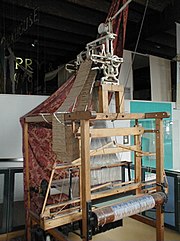Jacquard loom
From Wikipedia, the free encyclopedia
The Jacquard Loom is a mechanical loom, invented by Joseph Marie Jacquard in 1801, that simplifies the process of manufacturing textiles with complex patterns such as brocade, damask, and matelasse.[1] The loom is controlled by punchcards with punched holes, each row of which corresponds to one row of the design. Multiple rows of holes are punched on each card and the many cards that compose the design of the textile are strung together in order. It is based on earlier inventions by the Frenchmen Basile Bouchon (1725), Jean Falcon (1728) and Jacques Vaucanson (1740).[2]
Contents |
[edit] Principles of Operation
Each hole in the card corresponds to a "Bolus" hook, which can either be up or down. The hook raises or lowers the harness, which carries and guides the warp thread so that the weft will either lie above or below it. The sequence of raised and lowered threads is what creates the pattern. Each hook can be connected via the harness to a number of threads, allowing more than one repeat of a pattern. A loom with a 400 hook head might have four threads connected to each hook, resulting in a fabric that is 1600 warp ends wide with four repeats of the weave going across.
The term "Jacquard loom" is a misnomer. It is the "Jacquard head" that adapts to a great many dobby looms such as the "Dornier" brand that allow the weaving machine to then create the intricate patterns often seen in Jacquard weaving.
Jacquard looms, whilst relatively common in the textile industry, are not as ubiquitous as dobby looms which are usually faster and much cheaper to operate. However unlike jacquard looms they are not capable of producing so many different weaves from one warp. Modern jacquard looms are controlled by computers in place of the original punched cards, and can have thousands of hooks.
The threading of a Jacquard loom is so labor intensive that many looms are threaded only once. Subsequent warps are then tied in to the existing warp with the help of a knotting robot which ties each new thread on individually. Even for a small loom with only a few thousand warp ends the process of re-threading can take days.
[edit] Importance to Computing
The Jacquard loom was the first machine to use punch cards to control a sequence of operations. Although it did no computation based on them, it is considered an important step in the history of computing hardware.[3] The ability to change the pattern of the loom's weave by simply changing cards was an important conceptual precursor to the development of computer programming. Specifically, Charles Babbage planned to use cards to store programs in his Analytical engine.
[edit] See also
| Wikimedia Commons has media related to: Jacquard loom |
[edit] References
- ^ "Fabric Glossary". http://www.christinalynn.com/fabric-glossary.shtml. Retrieved on 2008-11021.
- ^ "Computer History Museum: First Data Storage". http://www.coe.uh.edu/courses/cuin7317/students/museum/slong.html.
- ^ Essinger, James (2004). Jacquard's Web: How a hand-loom led to the birth of the information age. Oxford: Oxford University Press. ISBN 0192805770.
|
|||||||||||||||||||
This article was originally based on material from the Free On-line Dictionary of Computing, which is licensed under the GFDL.





